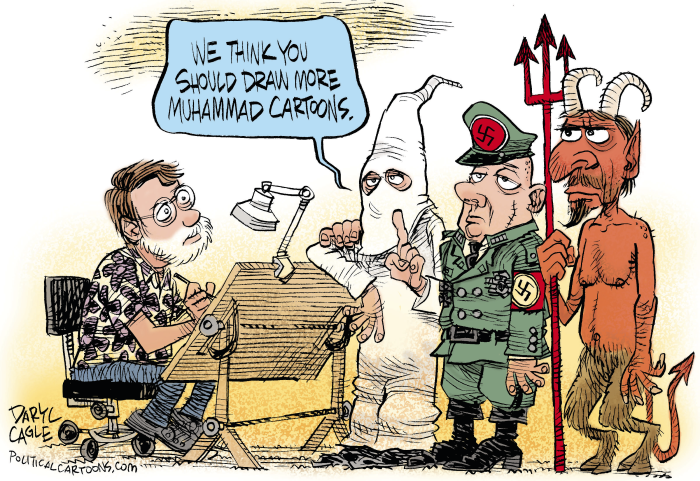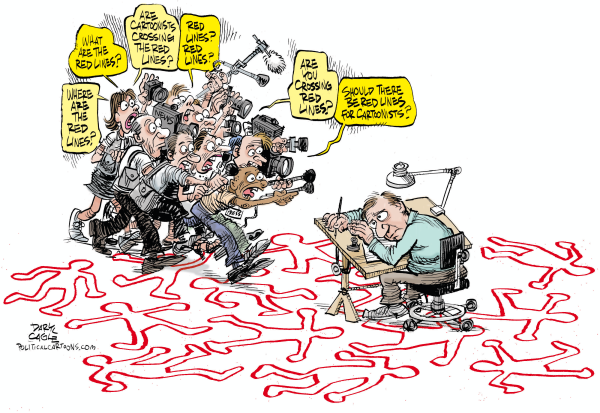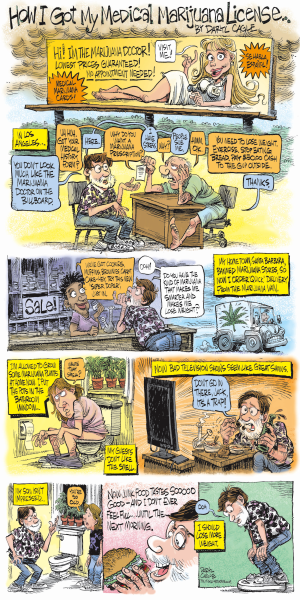
I’ve had a crazy week since I drew a cartoon of the Mexican flag, with the eagle shot dead by a stream of machine gun bullets. The cartoon illustrates the terrible violence in Mexico. Since President Felipe Calderón announced his war on the drug cartels, over 28,000 people have been killed in a civil war that shows no sign of easing. I got a spirited, angry reaction on my blog and in e-mails from Mexican readers who objected to my “desecration of the sacred Mexican flag.”
My cartoon appeared at the same time as Calderón‘s state of the union address to Mexico’s Congress in which Calderón claimed to be making progress in the worsening drug war. Mexico’s conservative, national newspaper Reforma, and other papers in their chain, published my cartoon at the top of their front pages. The convenient timing of my cartoon “scandal” was an opportunity for Reforma to make an effective front page dig at Calderón, and soon the cartoon was picked up by almost all of the other Mexican newspapers. The Mexican Embassy in Washington responded to the cartoon with a letter to my home publication, msnbc.com, stoking the cartoon controversy even more.
Many outraged Mexican readers pointed out that it is against the law in Mexico to alter the image of the flag – a law that didn’t deter Mexican newspapers from printing the cartoon.
There are raw nerves all around. I’m still being deluged with online comments and e-mails, half from angry Mexicans who think the image of their flag must never be tampered with. The Mexican mail is laced with colorful profanity, about how America is the cause of all of Mexico’s problems, with our demand for drugs and our guns fueling the violence.
The rest of the responses are supportive of my cartoon, some from Mexicans who say my cartoon describes how they feel, others from angry Americans who see any criticism of Mexico as supportive of their anti-immigrant fervor. Conservative readers seem to take glee in sending me dozens of photos of Mexicans disrespecting American flags in every imaginable way. The Mexican readers write that the American flag is “not the same” and “you Americans respect nothing – you wear your flag in your underwear!” (The flag-underwear reference is a popular one.) I also hear a lot about how “you Americans use your ‘freedom of speech’ to crap on everyone else!”
Another popular argument is that the “sacred” Mexican flag is just like the Prophet Muhammad, and no cartoonist should dare to draw the Mexican flag just as they wouldn’t dare to draw Muhammad. I generally respect religious beliefs and I shy away from religion bashing in my cartoons, but I don’t grant the same respect to governments. It is the role of editorial cartoonists to criticize governments and nations, and to use the symbols of nations in our cartoons. Cartoonists all around the world use flags in their cartoons and no country can opt out of criticism because they view their own flag as “sacred”. This attitude outrages my Mexican critics, especially since it comes from an ugly, foreign, American cartoonist.
Ever since the Danish Muhammad cartoon crisis I get mail on various topics, from readers who want offending cartoons removed, demanding apologies– “just like with the Danish Muhammad cartoons. “ In the old days readers would write thoughtful letters to the editor of their newspaper; now readers expect to interact in real time with the cartoonist; they want to strike back and get retribution for the perceived offense. A few hot-button topics always get the responses: Mexico/immigration, the Confederate battle flag, abortion, gun control, Israel vs. the Palestinians and Islam. The e-mails are always the same: punish, fire or educate the ignorant, racist cartoonist; ban the topic in cartoons; apologize.
Part of the friction comes from a basic misunderstanding of what an editorial cartoon is – some people think editorial cartoons are supposed to be funny jokes. A good editorial cartoon might be funny, it might make readers cry, or think – and sometimes a cartoon that makes readers angry is the most effective cartoon of all.
Daryl Cagle is a political cartoonist and blogger for MSNBC.com; he is a past president of the National Cartoonists Society. Daryl’s cartoons are syndicated to more than 850 newspapers, including the paper you are reading now. Daryl’s books “The BIG Book of Campaign 2008 Political Cartoons” and “The Best Political Cartoons of the Year, 2010 Edition” are available in bookstores now. Read Daryl’s blog at www.blog.cagle.com/daryl
















